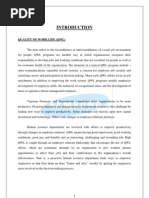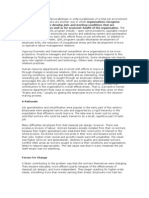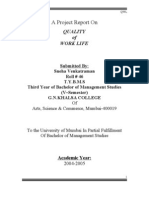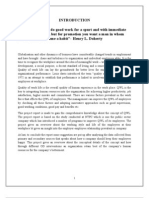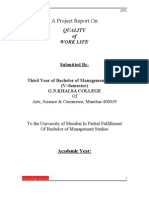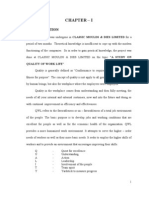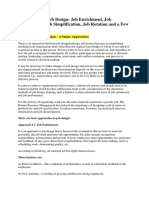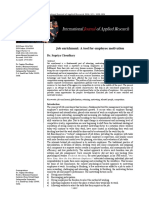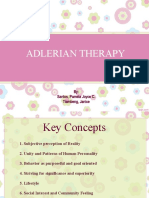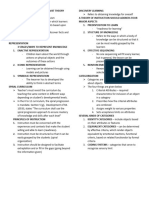HRD QWL
HRD QWL
Uploaded by
Vaibhav PatilCopyright:
Available Formats
HRD QWL
HRD QWL
Uploaded by
Vaibhav PatilCopyright
Available Formats
Share this document
Did you find this document useful?
Is this content inappropriate?
Copyright:
Available Formats
HRD QWL
HRD QWL
Uploaded by
Vaibhav PatilCopyright:
Available Formats
Quality of Work Life Project
WHAT IS QWL?
The term refers to the favourableness or unfavourableness of a total job environment for people. QWL programs are another way in which organisations recognise their responsibility to develop jobs and working conditions that are excellent for people as well as for economic health of the organisation. The elements in a typical QWL program include open communications, equitable reward systems, a concern for employee job security and satisfying careers and participation in decision making. Many early QWL efforts focus on job enrichment. In addition to improving the work system, QWL programs usually emphasise development of employee skills, the reduction of occupational stress and the development of more co-operative labour-management relations. Vigorous Domestic and International competition drive organisations to be more productive. Proactive managers and human resource departments respond to this challenge by finding new ways to improve productivity. Some strategies rely heavily upon new capital investment and technology. Others seek changes in employee relations practices. Human resource departments are involved with efforts to improve productivity through changes in employee relations. QWL means having good supervision, good working conditions, good pay and benefits and an interesting, challenging and rewarding job. High QWL is sought through an employee relations philosophy that encourages the use of QWL efforts, which are systematic attempts by an organisation to give workers greater opportunities to affect their jobs and their contributions to the organisations overall effectiveness. That is, a proactive human resource department finds ways to empower employees so that they draw on their brains and wits, usually by getting the employees more involved in the decision-making process. A Rationale Job specialisation and simplification were popular in the early part of this century. Employees were assigned narrow jobs and supported by a rigid hierarchy in the expectation that efficiency would improve. The idea was to lower cost by using unskilled workers who could be easily trained to do a small, repetitive part of each job. Many difficulties developed from that classical job design, however. There was excessive division of labour. Workers became socially isolated from their co-workers because their highly specialised jobs weakened their community of interest in the whole product. Deskilled workers lost pride in their work and became bored with their jobs. Higher-order (social and growth) needs were left unsatisfied. The result was higher turnover and absenteeism, declines in quality and alienated workers. Conflict often arose as workers sought to improve their conditions and organisations failed to respond appropriately. The real cause was that in many instances the job itself simply was not satisfying.
Forces For Change
A factor contributing to the problem was that the workers themselves were changing. They became educated, more affluent (partly because of the effectiveness of classical job design), and more independent. They began reaching for higher-order needs, something more than merely earning their bread. Employers now had two reasons for re-designing jobs and organisations for a better QWL: Classical design originally gave inadequate attention to human needs. The needs and aspirations of workers themselves were changing. Humanised Work Through QWL One option was to re-design jobs to have the attributes desired by people, and re-design organisations to have the environment desired by the people. This approach seeks to improve QWL. There is a need to give workers more of a challenge, more of a whole task, more opportunity to use their ideas. Close attention to QWL provides a more humanised work environment.It attempts to serve the higher-order needs of workers as well as their more basic needs. It seeks to employ the higher skills of workers and to provide an environment that encourages them to improve their skills. The idea is that human resources should be developed and not simply used. Further, the work should not have excessively negative conditions. It should not put workers under undue stress. It should not damage or degrade their humanness. It should not be threatening or unduly dangerous. Finally, it should contribute to, or at least leave unimpaired, workers abilities to perform in other life roles, such as citizen, spouse and parent. That is, work should contribute to general social advancement. Job Enlargement vs. Job Enrichment The modern interest in quality of work life was stimulated through efforts to change the scope of peoples jobs in attempting to motivate them. Job scope has two dimensions breadth and depth. Job breadth is the number of different tasks an individual is directly responsible for. It ranges from very narrow (one task performed repetitively) to wide (several tasks). Employees with narrow job breadth were sometimes given a wider variety of duties in order to reduce their monotony; this process is called job enlargement. In order to perform these additional duties, employees spend less time on each duty. Another approach to changing job breadth is job rotation, which involves periodic assignment of an employee to completely different sets of job activities. Job rotation is an effective way to develop multiple skills in employees, which benefits the organisation while creating greater job interest and career options for the employee. Job enrichment takes a different approach by adding additional motivators to a job to make it more rewarding. It was developed by Frederick Herzberg on the basis of his studies indicating that the most effective way to motivate workers was by focusing on higher-order needs. Job enrichment seeks to add depth to a job by giving workers more control, responsibility and discretion over hoe their job is performed.
You might also like
- Theories of Human Development 2nd EditionDocument398 pagesTheories of Human Development 2nd EditionMelisa Vasiliou90% (10)
- (Journal) J. Barton Cunningham and Ted Eberle - A Guide To Job Enrichment and Redesign PDFDocument5 pages(Journal) J. Barton Cunningham and Ted Eberle - A Guide To Job Enrichment and Redesign PDFAzwinNo ratings yet
- (Contemporary European Cultural Studies) Jose Guimon - Art and Madness-The Davies Group Publishers (2006) - 1Document271 pages(Contemporary European Cultural Studies) Jose Guimon - Art and Madness-The Davies Group Publishers (2006) - 1Ercan ŞimşekNo ratings yet
- QualityDocument2 pagesQualityShan SenaniNo ratings yet
- Quality of Work LifeDocument47 pagesQuality of Work LifeAsim MahatoNo ratings yet
- QWL at SamsungDocument100 pagesQWL at SamsungSubha BharathyNo ratings yet
- HR Term Paper 2003Document40 pagesHR Term Paper 200327mickieNo ratings yet
- Their Responsibility To Develop Jobs and Working Conditions That Are Excellent For People As Well As For Economic Health of The Organisation. TheDocument4 pagesTheir Responsibility To Develop Jobs and Working Conditions That Are Excellent For People As Well As For Economic Health of The Organisation. TheLakshmi RamanNo ratings yet
- Quality of Work LifeDocument99 pagesQuality of Work Lifefelix777sNo ratings yet
- QWL SnehaDocument103 pagesQWL SnehaRajasekaran SelvamNo ratings yet
- Quality of Work Life With Special Reference To NTPC - 2011Document77 pagesQuality of Work Life With Special Reference To NTPC - 2011Varsha Shishodia0% (1)
- Job Design AssignDocument6 pagesJob Design AssignimrannwlNo ratings yet
- Job Design AssignDocument7 pagesJob Design AssignJacob OnsareNo ratings yet
- Quality of Work LifeDocument99 pagesQuality of Work LifeBharat Ahuja100% (2)
- We Ashish Sarna, Jagdeep, Priya Gupta and Shilpa Students of JIMS KALKAJI Have Completed The Module OnDocument33 pagesWe Ashish Sarna, Jagdeep, Priya Gupta and Shilpa Students of JIMS KALKAJI Have Completed The Module OnShilpa KumarNo ratings yet
- Quality of WorklifeDocument47 pagesQuality of WorklifeAkhil DevraniNo ratings yet
- Job EnrichmentDocument9 pagesJob EnrichmentNitesh Bhura100% (1)
- MBA+Project Quality+of+Work+Life (1) .Document60 pagesMBA+Project Quality+of+Work+Life (1) .Divya Ram100% (1)
- Industrial Engineering Assignment: Name:-Chetanya RohillaDocument20 pagesIndustrial Engineering Assignment: Name:-Chetanya RohillaDHEERAJ kumarNo ratings yet
- NO Title/Question Pages: Assignment - Human Resources ManagementDocument26 pagesNO Title/Question Pages: Assignment - Human Resources Managementzakuan79No ratings yet
- Impact On Job Enrichment and Employee MotivationDocument68 pagesImpact On Job Enrichment and Employee MotivationHeena SultanNo ratings yet
- CASE STUDY ANS (1) Employee Motivation Is The Level of Energy, Commitment, and Creativity That A Company'sDocument8 pagesCASE STUDY ANS (1) Employee Motivation Is The Level of Energy, Commitment, and Creativity That A Company'skajal_sharma6200No ratings yet
- Micro Job Crafting - tcm18 59082Document8 pagesMicro Job Crafting - tcm18 59082Ignatia AristaNo ratings yet
- 3 ChapterDocument29 pages3 ChapterSahil GouthamNo ratings yet
- Abstract.: Key Words: Quality of Work Life, Job Satisfaction and Work EnvironmentDocument6 pagesAbstract.: Key Words: Quality of Work Life, Job Satisfaction and Work EnvironmentPadmasunNo ratings yet
- Approaches To Job DesignDocument8 pagesApproaches To Job DesignPahulpreet SinghNo ratings yet
- Barani Institute of Information and Technology: Psychology PresentationDocument17 pagesBarani Institute of Information and Technology: Psychology PresentationMuddasar YaminNo ratings yet
- Rupesh - HR Job EnrichmentDocument66 pagesRupesh - HR Job Enrichmentrupesh verma100% (2)
- WORKFLOW ANALYSIS AND JOB DESIGNDocument3 pagesWORKFLOW ANALYSIS AND JOB DESIGNrajja.rashad20No ratings yet
- DR SupriyaDocument5 pagesDR SupriyangurahwNo ratings yet
- Synopsis Report On Quality of Work LifeDocument5 pagesSynopsis Report On Quality of Work LifeManisha MishraNo ratings yet
- Assignment HR - 9 OD InterventionsDocument6 pagesAssignment HR - 9 OD InterventionsDeborina BhattacharyyaNo ratings yet
- Quality of Work Life KesoramDocument76 pagesQuality of Work Life KesoramyourstruelyudayNo ratings yet
- Omer ProjectDocument67 pagesOmer ProjectRay 007No ratings yet
- Project On Job EnrichmentDocument14 pagesProject On Job Enrichmentarpana_sinhaNo ratings yet
- 3:30 PM - 5:00 Pm/tth/acd-406Document6 pages3:30 PM - 5:00 Pm/tth/acd-406Reymond Grana AtienzaNo ratings yet
- Job Design Write Up FINALDocument11 pagesJob Design Write Up FINALharitvineetNo ratings yet
- HRM 2.3Document9 pagesHRM 2.3Piyush SinglaNo ratings yet
- Importance of Employee Motivation and Appraisal As Part of The Planning For A Major Company Involving and Implementing Change in The WorkforceDocument4 pagesImportance of Employee Motivation and Appraisal As Part of The Planning For A Major Company Involving and Implementing Change in The WorkforceAdnan Yusufzai100% (1)
- A Study On Quality of Work Life: Key Elements & It's ImplicationsDocument4 pagesA Study On Quality of Work Life: Key Elements & It's ImplicationsAbirami DjNo ratings yet
- Untitled DocumentDocument4 pagesUntitled Documentsky.dumpacc00No ratings yet
- Job DesysewrtqDocument18 pagesJob Desysewrtqzeeshanshani1118No ratings yet
- Ali Ahsan Khan MADocument4 pagesAli Ahsan Khan MAMuhammad Ali Ahsan KhanNo ratings yet
- Job EnrichmentDocument3 pagesJob EnrichmentSupriya Surian MNo ratings yet
- Siddu Final Project-1Document53 pagesSiddu Final Project-1aneshsahu03No ratings yet
- Final Project Report On QWLDocument71 pagesFinal Project Report On QWLRekha MohanNo ratings yet
- Job Redesign ProjDocument20 pagesJob Redesign ProjRenu Yadav100% (1)
- Ob Unit VDocument46 pagesOb Unit V20s41a6622No ratings yet
- Staff Review and Development Appraisal Procedure: FeedbackDocument17 pagesStaff Review and Development Appraisal Procedure: Feedbackzeeshanshani1118No ratings yet
- QWL ManoramaDocument127 pagesQWL ManoramaAnil Kumar SinghNo ratings yet
- Job Design: - What Will Be Done in A Job - Who Will Do The Job - How The Job Will Be Done - Where The Job Will Be DoneDocument9 pagesJob Design: - What Will Be Done in A Job - Who Will Do The Job - How The Job Will Be Done - Where The Job Will Be DoneIsabelle AmbataliNo ratings yet
- Quality of Work LifeDocument43 pagesQuality of Work LifeRohit Shet100% (1)
- Production and Operations ManagementDocument5 pagesProduction and Operations ManagementsinchucNo ratings yet
- Work Design Has Been Researched and Applied Extensively in OrganizationsDocument21 pagesWork Design Has Been Researched and Applied Extensively in OrganizationsRimsha Noor ChaudaryNo ratings yet
- Managing Others: The Organisational Essentials: Your guide to getting it rightFrom EverandManaging Others: The Organisational Essentials: Your guide to getting it rightNo ratings yet
- The ACE Advantage: How Smart Companies Unleash Talent for Optimal PerformanceFrom EverandThe ACE Advantage: How Smart Companies Unleash Talent for Optimal PerformanceNo ratings yet
- My Red ThreadDocument4 pagesMy Red Threadapi-282116090No ratings yet
- Promoting Self-Regulation in The First Five Years: A Practice BriefDocument9 pagesPromoting Self-Regulation in The First Five Years: A Practice BriefHoa Nhu LeNo ratings yet
- Full ThesisDocument165 pagesFull Thesissivagiri.p100% (1)
- Giving Expanded Definition of WordsDocument7 pagesGiving Expanded Definition of WordsCarlo CasumpongNo ratings yet
- Scott A. Miller-Parenting and Theory of Mind-Oxford University Press (2016)Document369 pagesScott A. Miller-Parenting and Theory of Mind-Oxford University Press (2016)Lacatus Olimpiu100% (1)
- MGT1103 L8 LeadershipDocument24 pagesMGT1103 L8 LeadershipTe HwNo ratings yet
- Thesis - Personality, - Self - Efficacy - An PDFDocument689 pagesThesis - Personality, - Self - Efficacy - An PDFAlexander AlexanderNo ratings yet
- RSPM Manual BasicDocument15 pagesRSPM Manual BasicSweata DasNo ratings yet
- Module 2Document8 pagesModule 2Regine SojorNo ratings yet
- Rps CcuDocument7 pagesRps CcuJalo DoankNo ratings yet
- Appraisal Form GenericDocument4 pagesAppraisal Form GenericAnonymous U8Po8HJQzrNo ratings yet
- Essay 1Document4 pagesEssay 1api-743869016No ratings yet
- 12 Basic Principles in Preparing Learning and Teaching MaterialDocument4 pages12 Basic Principles in Preparing Learning and Teaching MaterialOctaviaa D'law50% (2)
- PERSONAL DEVELOPMENT Various Roles of Different Individuals in Society and How They Can Influence People Through Their Leadership or FollowershipDocument11 pagesPERSONAL DEVELOPMENT Various Roles of Different Individuals in Society and How They Can Influence People Through Their Leadership or Followershipthomassyd84No ratings yet
- Hexaflex and TriflexDocument3 pagesHexaflex and TriflexRan AlmogNo ratings yet
- Functional Neurological Disorders: The Neurological Assessment As TreatmentDocument11 pagesFunctional Neurological Disorders: The Neurological Assessment As Treatmentjoao marcelo lealNo ratings yet
- Burn Out Recovery PlanDocument2 pagesBurn Out Recovery PlanFriska RiantiNo ratings yet
- Therapy Manuals For Drug AbuseDocument110 pagesTherapy Manuals For Drug Abuseandreiamocan9724No ratings yet
- SAS 12 Edu 530Document5 pagesSAS 12 Edu 530Jonarie Asuncion TagudinNo ratings yet
- Ayesha 91Document3 pagesAyesha 91imtiaz hussainNo ratings yet
- The Nature and Importance of Leadership: Chapter Outline and Lecture NotesDocument134 pagesThe Nature and Importance of Leadership: Chapter Outline and Lecture NotesLeila AbotiraNo ratings yet
- Personality Strength and Situational in Uences On Behavior: A Conceptual Review and Research AgendaDocument28 pagesPersonality Strength and Situational in Uences On Behavior: A Conceptual Review and Research AgendaAlina PopescuNo ratings yet
- Educational Psychology IDocument7 pagesEducational Psychology IWidad GaNo ratings yet
- Adlerian PPTS&TDocument20 pagesAdlerian PPTS&TPamela joyce c. santosNo ratings yet
- The Influence-of-Ethical-Leadership-on-Employee-Work-Related-Stress-and-Organizational-Commitment-Evidence-from-a-Developing-CountryDocument17 pagesThe Influence-of-Ethical-Leadership-on-Employee-Work-Related-Stress-and-Organizational-Commitment-Evidence-from-a-Developing-Countryელიო კრუზიNo ratings yet
- FLCT FinalDocument8 pagesFLCT Finalchristine rascoNo ratings yet
- Dokumen - Tips - Ebook The Common Path To Uncommon Success A Roadmap To Financial Freedom and FulfillmentDocument5 pagesDokumen - Tips - Ebook The Common Path To Uncommon Success A Roadmap To Financial Freedom and FulfillmentDavid RobertNo ratings yet
- 2023 Manifesting PlannerDocument529 pages2023 Manifesting Plannerhey its me100% (1)





